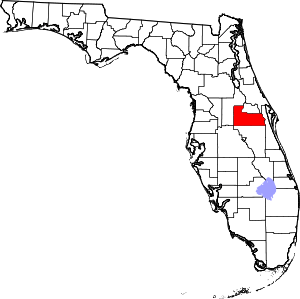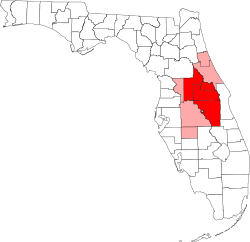Maitland, Florida
Maitland is a suburban city in Orange County, Florida, United States, part of the Greater Orlando area. The population was 15,751 at the 2010 census.[5] The area's history is exhibited at the Maitland Historical Museum. The city also hosts the Maitland Art Center, and examples of Mayan Revival architecture and Fantasy Architecture, the Maitland Telephone Museum and the William H. Waterhouse House Museum. A SunRail station is located in Maitland on Highway 17-92. The city is named for Fort Maitland.
Maitland, Florida | |
|---|---|
| Motto(s): A Community For Life | |
 | |
 U.S. Census Map | |
| Coordinates: 28°37′37″N 81°22′1″W | |
| Country | |
| State | |
| County | Orange |
| Incorporated (Town) | July 17, 1885 |
| Incorporated (City) | June 1, 1959 |
| Area | |
| • Total | 6.42 sq mi (16.6 km2) |
| • Land | 5.28 sq mi (13.7 km2) |
| • Water | 1.13 sq mi (2.9 km2) |
| Elevation | 89 ft (27 m) |
| Population (2010) | |
| • Total | 15,751 |
| • Estimate (2019)[2] | 17,652 |
| • Density | 2,500/sq mi (950/km2) |
| Time zone | UTC-5 (Eastern (EST)) |
| • Summer (DST) | UTC-4 (EDT) |
| ZIP codes | 32751, 32794 |
| Area code(s) | 407, 689 |
| FIPS code | 12-42575[3] |
| GNIS feature ID | 0286318[4] |
| Website | www |
History
Maitland is one of the oldest incorporated suburban municipalities in central Florida. The area was previously inhabited by Timucuan Native Americans. The town was originally named for a nearby Lake, which honored Captain William Seton Maitland, who fought in the Second Seminole Indian War, and was slain in the battle of Wahoo Swamp. A small military outpost was built in 1838 on the western shore of Lake Fumecheliga (later Lake Maitland) during the Second Seminole War. After the Civil War, new residents arrived in the area. Christopher Columbus Beasley, perhaps the first permanent settler, arrived at Lake Maitland in 1871. A post office opened on January 2 of the next year and operated in his home.[6] Around this post office, a small town grew. In the closing decades of the nineteenth century the area was put into extensive citrus production.[7]
Lake Maitland was incorporated as a town in 1885, the third such town in Orange County to do so. In its infancy, Lake Maitland was often characterized as a rural village, with streets lined with large oak trees planted by early town aldermen. However, the old town began to rapidly modernize as Orlando's suburban sprawl reached the town in the mid 1920s.

During this period the town grew rapidly as new houses and roads were built. In 1959, Maitland was incorporated as a city.
Maitland is a suburb of Orlando. The town's "historical corridor" encompasses old residences still standing and occupied in the Lake Lily-Lake Catherine area and extending through the central portion of the city. Examples of these century-old structures include "The Church of the Good Shepherd" (1883); "William H. Waterhouse House" (1884), and the "Maitland Art Center" (1937) .[7] The area has always been a vacation spot because of its climate, location to theme parks and people. Maitland has many picturesque parks along lakes, which attract many boaters.
Geography
Maitland is located at 28°37′37″N 81°22′1″W (28.626926, −81.366961).[8]
According to the United States Census Bureau, the city has a total area of 6.4 square miles (16.6 km2), of which 5.3 square miles (13.6 km2) is land and 1.2 square miles (3.0 km2) (17.84%) is water. The city of Maitland has a total of 21 lakes, the largest being Lake Maitland (451 acres).[9]
Demographics
| Historical population | ||
|---|---|---|
| Year | Pop. | ±% |
| 1900 | 136 | — |
| 1910 | 157 | +15.4% |
| 1920 | 172 | +9.6% |
| 1930 | 511 | +197.1% |
| 1940 | 463 | −9.4% |
| 1950 | 889 | +92.0% |
| 1960 | 3,570 | +301.6% |
| 1970 | 7,157 | +100.5% |
| 1980 | 8,763 | +22.4% |
| 1990 | 9,110 | +4.0% |
| 2000 | 12,019 | +31.9% |
| 2010 | 15,751 | +31.1% |
| 2019 | 17,652 | +12.1% |
| U.S. Decennial Census[10] | ||
As of the census[3] of 2000, there were 12,019 people, 4,825 households, and 3,242 families residing in the city. The population density was 2,589.1 inhabitants per square mile (1,000.1/km²). There were 5,104 housing units at an average density of 1,099.5 per square mile (424.7/km²). The racial makeup of the city was 85.22% White, 9.73% African American, 0.12% Native American, 2.18% Asian, 0.01% Pacific Islander, 1.16% from other races, and 1.58% from two or more races. Hispanic or Latino of any race were 5.97% of the population.
There were 4,825 households out of which 32.6% had children under the age of 18 living with them, 53.4% were married couples living together, 10.9% had a female householder with no husband present, and 32.8% were non-families. 27.1% of all households were made up of individuals and 10.3% had someone living alone who was 65 years of age or older. The average household size was 2.45 and the average family size was 3.01.

In the city, the population was spread out with 25.5% under the age of 18, 5.2% from 18 to 24, 29.1% from 25 to 44, 24.0% from 45 to 64, and 16.2% who were 65 years of age or older. The median age was 40 years. For every 100 females, there were 89.5 males. For every 100 females age 18 and over, there were 84.9 males.
The median income for a household in the city was $62,500, and the median income for a family was $69,504. Males had a median income of $53,542 versus $30,256 for females. The per capita income for the city was $37,290. About 3.5% of families and 6.4% of the population were below the poverty line, including 6.1% of those under age 18 and 8.5% of those age 65 or over.
Economy
The Maitland Center was established in 1982 adjacent to Interstate 4. Today its 226 acres (91 ha) include over 400 businesses and over 45 office buildings.[11]
Worldwide Brands has its headquarters in Maitland.[12]
Other local employers include:
- EA Tiburon, makers of the popular Madden NFL series and NCAA Football series
- Sonny's Real Pit Bar-B-Q
- Fidelity Integrated Financial Solutions[13]
- Charles Schwab Corporation
SunRail, the regional commuter rail service, operates a passenger rail station in Maitland. The first 31-mile (50 km) segment of the system (between DeBary and Sand Lake Road in Orange County) began operations on May 1, 2014.
Culture and recreation
Maitland is home to the nationally recognized and Central Florida's only full-time independent movie theater, Enzian Theater, in turn home to the Florida Film Festival. Maitland is also home to the Art & History Museums – Maitland, including the Maitland Art Center (formerly the Research Studio, 1937), which is a designated a National Historic Landmark (2014) for its unique Mayan Revival and Fantasy Architecture; the Maitland Historical Museum; the Maitland Telephone Museum; the William H. Waterhouse House Museum, also listed on the National Register of Historic Places ; and the Carpentry Shop Museum. Maitland is also home to The Roth Family Jewish Community Center of Greater Orlando, which serves as the center of Jewish life in Orlando and welcomes people of all backgrounds.[14]
In August 2005 the Maitland Little League team made it to the semifinals of the 2005 Little League World Series.[15]
Notable people
- Dante Bichette, former MLB player
- Chip Caray, TBS's lead play-by-play announcer for the Atlanta Braves and the number two play-by-play man for college football on WTBS
- Jazzy Danziger, winner of the Brittingham Prize in Poetry
- Jan Fortune, former state representative
- Buddy Morrow, leader of the Tommy Dorsey Orchestra
- Michael James Nelson, television actor, writer, producer
- John M. Pierce, writer on and promoter of amateur telescope making
- Mike Stanley, former MLB player
- J. Andre Smith, artist and architect; founder of the Research Studio (now known as the Maitland Art Center)
Education
Orange County Public Schools operates public schools in Maitland.
- Dommerich Elementary School
- Hungerford Elementary School
- Lake Sybelia Elementary School
- Maitland Middle School
Private schools include:
- Maitland Montessori School
- Jewish Academy of Orlando
- Orangewood Christian School
- Park Maitland School
- King of Kings Lutheran School (K3-8) [16]
Institutions of higher education include:
Museums and libraries
- Maitland Historical Museum
- The Maitland Public Library was instituted in 1896, when Mrs. Clara J. Dommerich donated several hundred volumes of books from her personal library for the townspeople of Maitland to share. Originally housed in a citizen's home, the collection was subsequently moved to a storefront near the railroad depot and then to its current home on South Maitland Avenue, with renovations and expansions conducted in 1959, 1972, and 1989. All expenditures were funded by donations until the City of Maitland took over the funding for the library in 1965, when it budgeted $12,332 to the library's operations. In 1972, Maitland government realized it could not use city tax money to build on the private property where the library stood. The Library's board turned over all assets, including the grounds, the building and the entire collection, to the city. Today, the library building and operating budget is funded and its grounds and buildings maintained by the city. The library remains, as it was in the beginning, a non-profit corporation that is operated by city residents, including a board of trustees, who are volunteers who meet monthly to participate in library business and decision-making. The library is a business and can still receive gifts and donations, which contribute immensely to the Library's funding. The Friends of the Library are an active group that contribute time and monies to the library for books and supplies, partly through their volunteer-run bookstore that is stocked by donations. Annual "Big Book Sales" are held by the Friends at the bookstore, courtyard and library Community Room.
 Maitland Public Library
Maitland Public Library - Telephone Museum
- Waterhouse Carpentry Museum
Points of interest

- Maitland Art Center
- Enzian Theater
- Lake Maitland
- RDV Sportsplex
- William H. Waterhouse House
- Jewish Community Center of Greater Orlando
- Holocaust Memorial Resource and Education Center of Florida
- Audubon Center for Birds of Prey
- Howell Branch Nature Preserve and Park
- Lake Lily – Location for the Maitland Art Festival
- Lake Minnehaha
- Lake Sybelia
- Maitland Community Park
- Maitland Farmer's Market
- Quinn Strong Park
References
- "2016 U.S. Gazetteer Files". United States Census Bureau. Retrieved Jul 7, 2017.
- "U.S. Census website". United States Census Bureau. Retrieved 2008-01-31.
- "US Board on Geographic Names". United States Geological Survey. 2007-10-25. Retrieved 2008-01-31.
- "Profile of General Population and Housing Characteristics: 2010 Demographic Profile Data (DP-1): Maitland city, Florida". United States Census Bureau. Retrieved September 20, 2012.
- "United States Postal Service Postmaster Finder".
- "US Gazetteer files: 2010, 2000, and 1990". United States Census Bureau. 2011-02-12. Retrieved 2011-04-23.
- "Geographic Identifiers: 2010 Demographic Profile Data (G001): Maitland city, Florida". United States Census Bureau. Retrieved September 20, 2012.
- "Census of Population and Housing". Census.gov. Retrieved June 4, 2015.
- "Maitland: A Community For Life". Retrieved on January 22, 2011.
- "We're Here To Help When You Need Us!" Worldwide Brands. Retrieved on February 26, 2010.
- "Company profile from Hoover's" Fidelity Integrated Financial Solutions. Retrieved on January 22, 2011.
- "About The Roth Family JCC of Greater Orlando". Retrieved May 11, 2015.
- "School Home".


